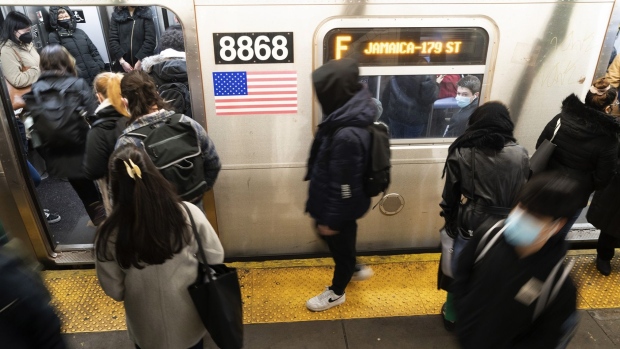Dec 19, 2022
NYC Subway Riders May Face Weekday Service Cuts in Post-Covid Shift
, Bloomberg News

(Bloomberg) -- Riders on some New York City subway lines may see less service on Mondays and Fridays and an increase on weekends as the biggest US transit system adjusts to a post-pandemic landscape.
While subway ridership is higher on weekdays than on weekends, usage on Saturdays and Sundays is about 75% of pre-pandemic levels, compared with just over 60% during the week, according to data from the Metropolitan Transportation Authority, the state agency that runs the city’s subways, buses and commuter rail lines.
The proposed changes, if approved by MTA’s board, would begin in June.
Weekday subway ridership has struggled to match 2019 usage as many people continue to work from home at least part of the week. Average Thursday ridership during morning rush hours in the fall was about 380,000, compared with about 280,000 on Fridays, MTA data show.
“The changes reflect what our customers are asking for and how our customers are using our service, which is more weekend service proportional to pre-Covid and less on Mondays and Fridays,” Rich Davey, head of MTA’s subways and buses, said Monday during an MTA committee meeting.
The MTA plans to reduce subway service on the 1, 6, 7, E ,F, L and Q lines on Mondays and Fridays. Even so, those changes mean riders are estimated to wait only an additional three to 30 seconds on those days, Davey said.
On the weekends, the MTA will boost subway service on the G, J and M lines, improving wait time by two minutes, Davey said.
The changes will save the agency an estimated $1.5 million, although the adjustments are meant to better match subway usage rather than find cost savings, Davey said. He briefed MTA board members on the proposed changes Monday, and the board will vote on the service adjustments at a future meeting.
The changes would come as the MTA plans to boost fares by 5.5% in 2023 and 2025, with the cost of a single subway ride increasing to $3.05 in 2025 from $2.75 now.
©2022 Bloomberg L.P.





